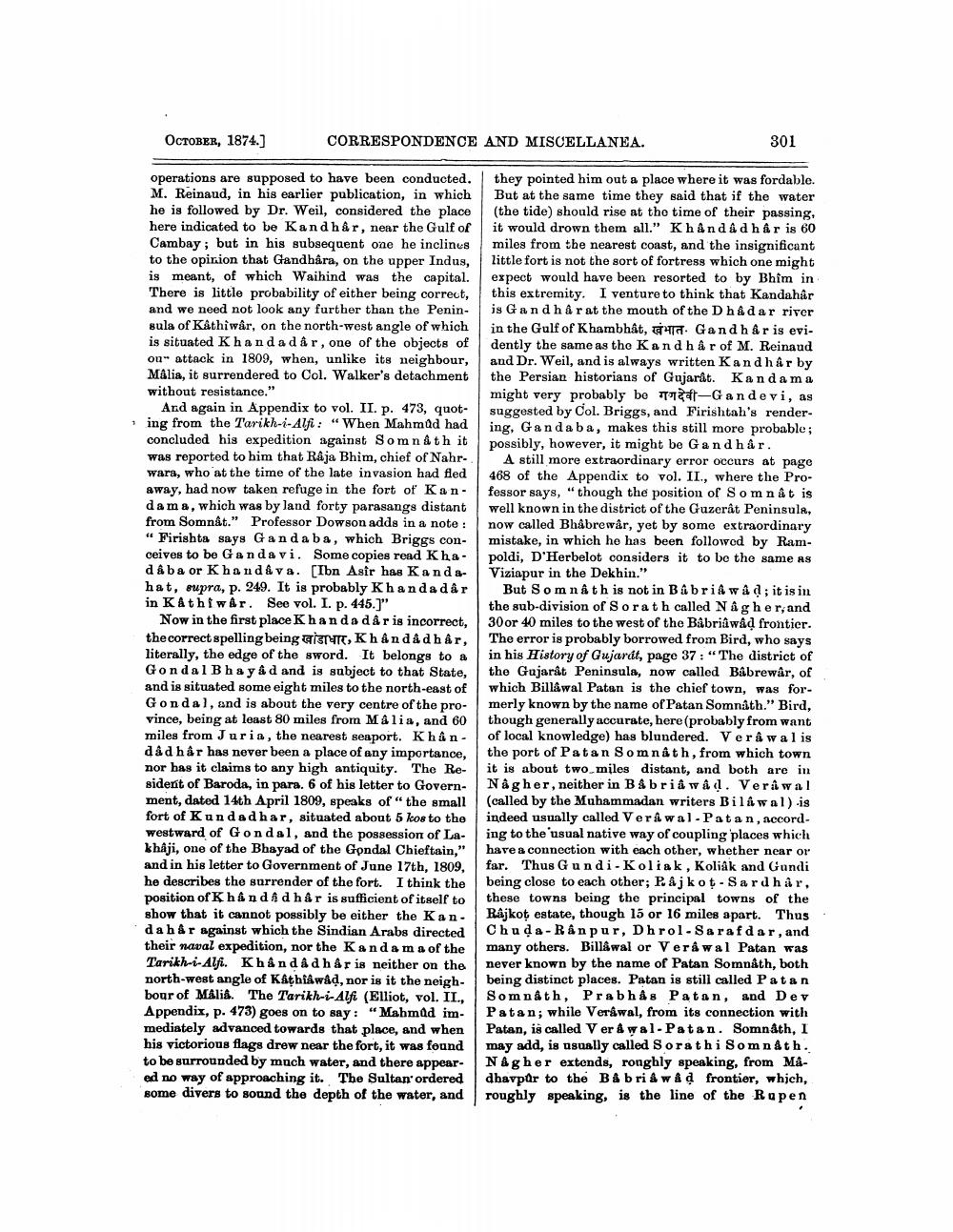________________
OCTOBER, 1874.]
CORRESPONDENCE AND MISCELLANEA.
301
operations are supposed to have been conducted, M. Reinaud, in his earlier publication, in which he is followed by Dr. Weil, considered the place here indicated to be Kandhår, near the Gulf of Cambay; but in his subsequent one he inclinus to the opinion that Gandhåra, on the upper Indus, is meant, of which Waihind was the capital. There is little probability of either being correct, and we need not look any further than the Peninsula of Kathiwâr, on the north-west angle of which is situated Khandad år, one of the objects of ou" attack in 1809, when, unlike its neighbour, Mália, it surrendered to Col. Walker's detachment without resistance."
And again in Appendix to vol. II. p. 473, quoting from the Tarikh-i-Alfi : “When Mahmud had concluded his expedition against Somnath it was reported to him that Raja Bhim, chief of Nahrwara, who at the time of the late invasion had fled away, had now taken refuge in the fort of Kan. dama, which was by land forty parasangs distant from Somnat." Professor Dowson adds in a note : " Firishta says Gandaba, which Briggs conceives to be Gandavi. Some copies read Kha. d å ba or Khand & va. [Ibn Asir has Kandahat, supra, p. 249. It is probably Khandadar in Kathiwar. See vol. I. p. 445.)"
Now in the first place Khanda dar is incorrect, the correct spelling being ITU, Khåndåd har, literally, the edge of the sword. It belongs to a Gondal Bhayad and is subject to that State, and is situated some eight miles to the north-east of Gondal, and is about the very centre of the province, being at least 80 miles from Malia, and 60 miles from Juria, the nearest seaport. Khân. dåd har has never been a place of any importance, nor has it claims to any high antiquity. The Residerit of Baroda, in para. 6 of his letter to Government, dated 14th April 1809, speaks of "the small fort of Kundadhar, situated about 5 kos to the westward of Gondal, and the possession of La- khâji, one of the Bhayad of the Gondal Chieftain," and in his letter to Government of June 17th, 1809, he describes the surrender of the fort. I think the position of Khand Adhar is sufficient of itself to show that it cannot possibly be either the Kan. da h&r against which the Sindian Arabs directed their naval expedition, nor the Kanda ma of the Tarikh-i-Alfi. Khånda dh&r is neither on the north-west angle of Kathiawad, nor is it the neighbour of Malia. The Tarikh-i-Alfi (Elliot, vol. II., Appendix, p. 473) goes on to say: "Mahmud im-
diately advanced towards that place, and when his victorious flags drew near the fort, it was found to be surrounded by much water, and there appear ed no way of approaching it. The Sultan' ordered some divers to sound the depth of the water, and
they pointed him out a place where it was fordable. But at the same time they said that if the water (the tide) should rise at the time of their passing, it would drown them all." Khåndåd har is 60 miles from the nearest coast, and the insignificant little fort is not the sort of fortress which one might expect would have been resorted to by Bhim in this extremity. I venture to think that Kandahar is Gandhår at the mouth of the Dhadar river in the Gulf of Khambhất, HG Gandhar is evidently the same as the Kand hår of M. Reinaud and Dr. Weil, and is always written Kandhar by the Persian historians of Gujarat. Kanda ma might very probably be t-Gandevi, as suggested by Col. Briggs, and Firishtah's rendering, Gandaba, makes this still more probable; possibly, however, it might be Gandh år.
A still more extraordinary error occurs at page 468 of the Appendix to vol. II., where the Professor says, "though the position of Somnat is well known in the district of the Guzerât Peninsula, now called Bhåbrewâr, yet by some extraordinary mistake, in which he has been followed by Rampoldi, D'Herbelot considers it to be the same as Viziapur in the Dekhin."
But Somnath is not in Babri& wå d; it is in the sub-division of Sorath called Någ her, and 30 or 40 miles to the west of the Babriâwâų frontier. The error is probably borrowed from Bird, who says in his History of Gujardt, page 37: "The district of the Gujarat Peninsula, now called Babrewâr, of which Billwal Patan is the chief town, was formerly known by the name of Patan Somnath." Bird, though generally accurate, here (probably from want of local knowledge) has blundered. Veriwal is the port of Patan Somnath, from which town it is about two miles distant, and both are in Någher, neither in B & bria wad. Verawal (called by the Muhammadan writers Bilawal) is indeed usually called Verawal. Patan, according to the usual native way of coupling places which have a connection with each other, whether near or far. Thus Gundi. Koliak, Koliak and Gandi being close to each other; P. & j k o t - Sard hår, these towns being the principal towns of the Rajkot estate, though 15 or 16 miles apart. Thus Chuda-Ranpur, Dhrol. Sarafdar, and many others. Billâwal or Verâ wal Patan was never known by the name of Patan Somnath, both being distinct places. Patan is still called Patan Somnath, Prabhas Patan, and Dev Patan; while Verwal, from its connection with Patan, is called V er Ayal-Patan. Somnath, I may add, is usually called Sorathi Somnath. Nagher extends, ronghly speaking, tre N&gher extends, ronghly speaking, from MAdhavpar to the B&b ri å wåd frontier, which, roughly speaking, is the line of the Repen




